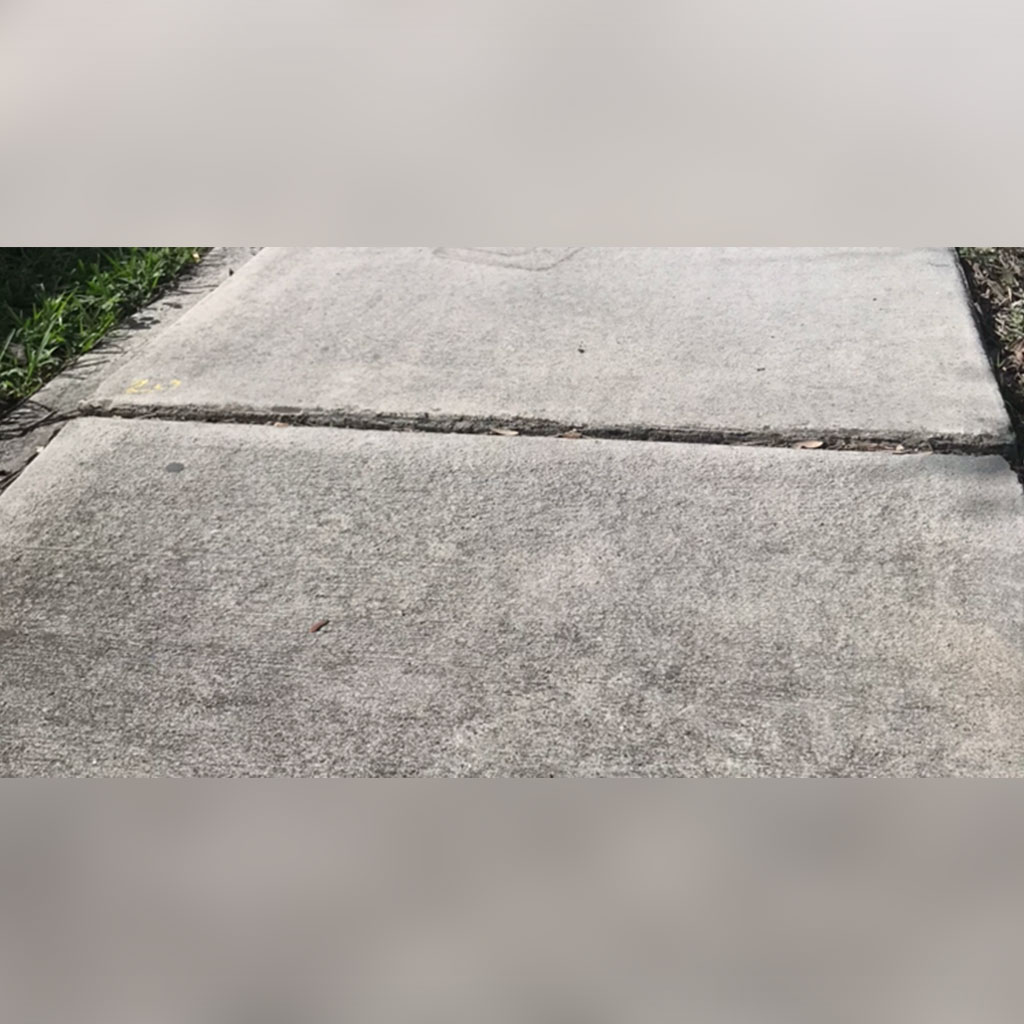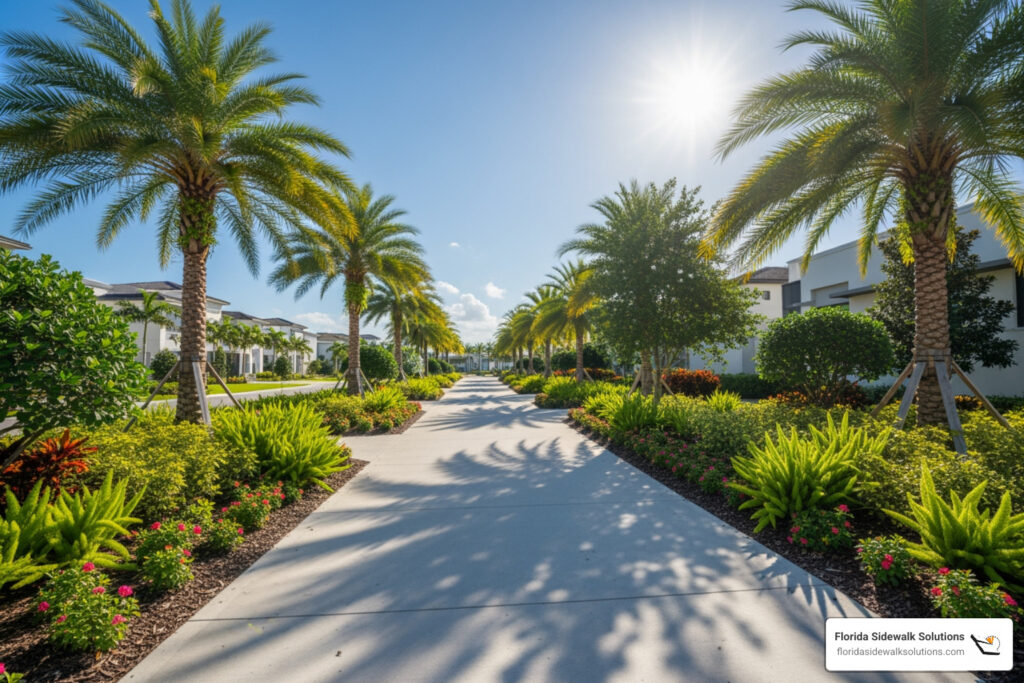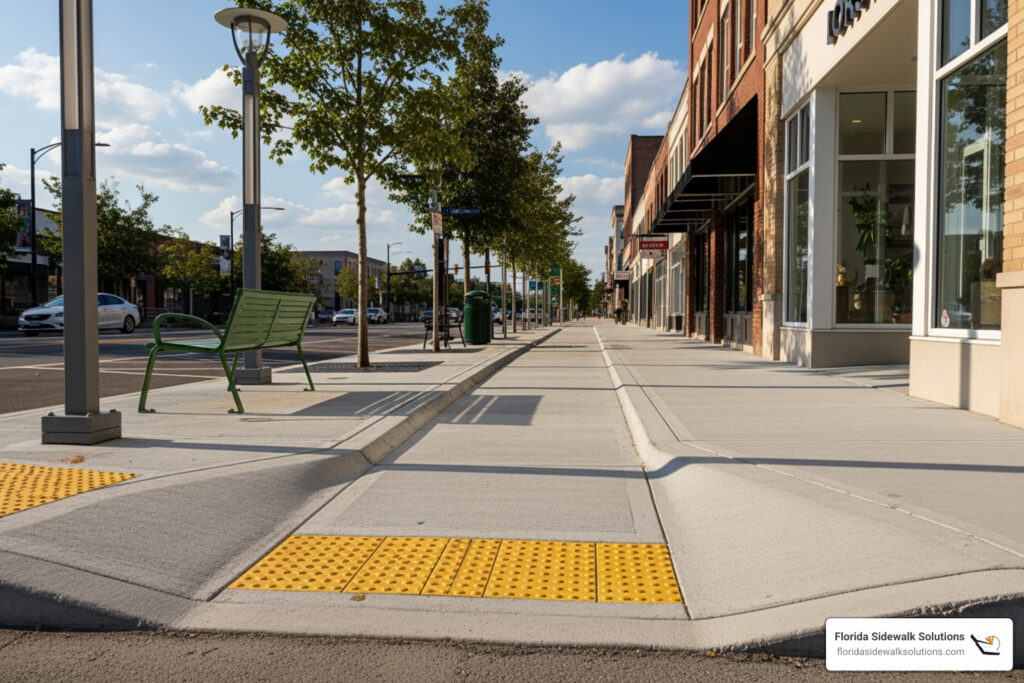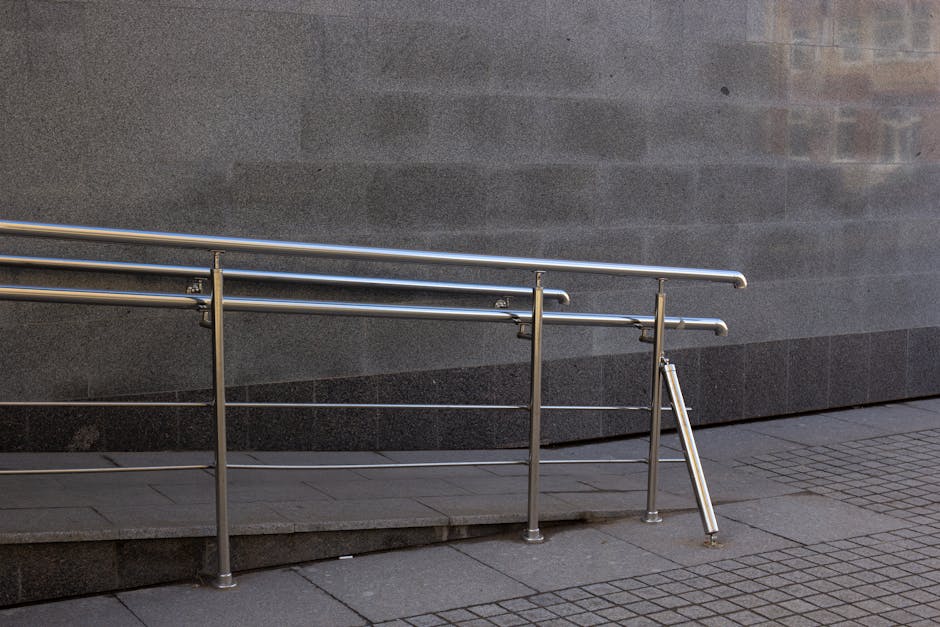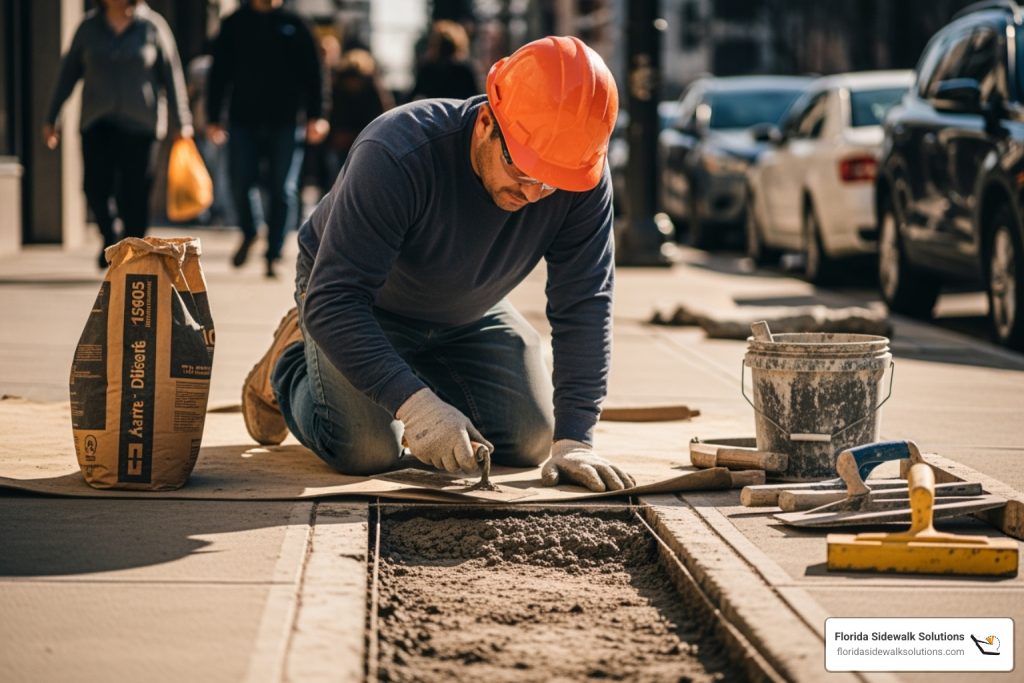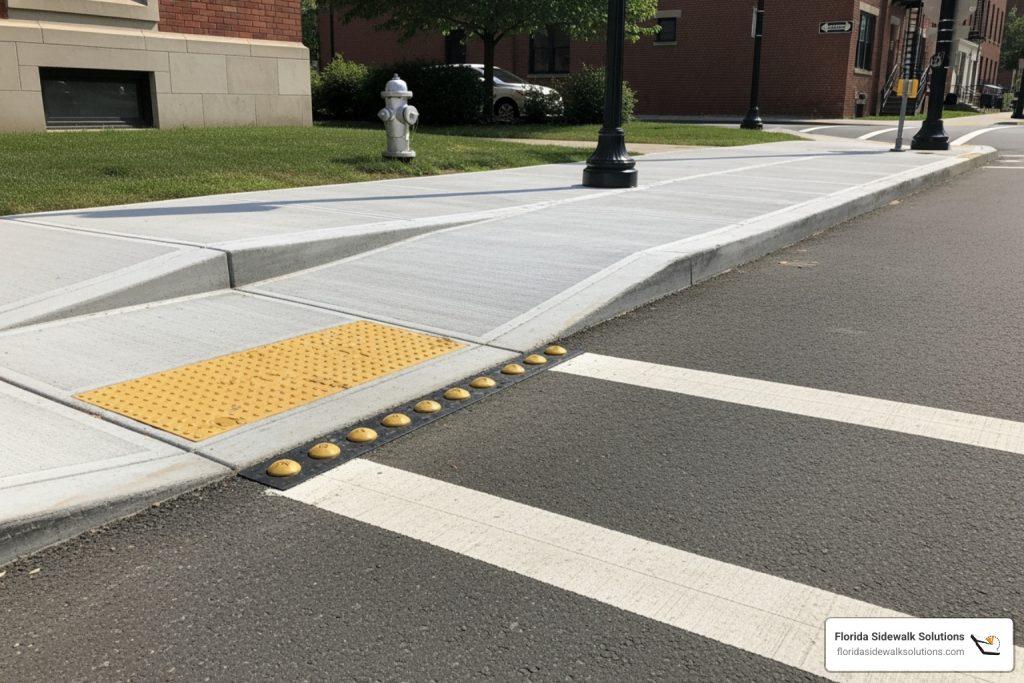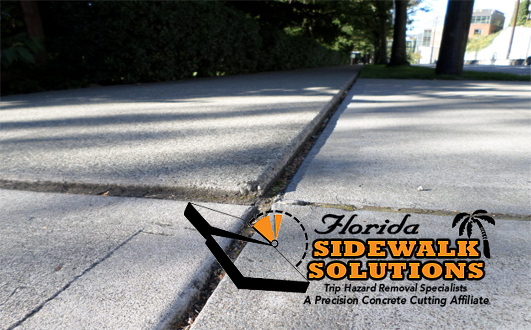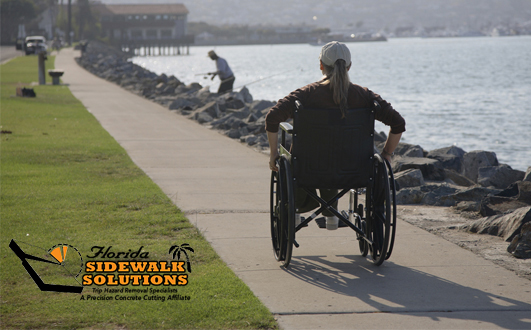Understanding ADA Compliance for Sidewalks
ADA compliant concrete solutions are essential for cities looking to make sidewalks safer, accessible, and compliant with Americans with Disabilities Act (ADA) standards. For municipalities facing uneven or hazardous sidewalks, here’s what you need to know right now:
What are ADA compliant concrete solutions?
ADA compliant concrete solutions involve repairing uneven sidewalks and removing trip hazards to meet ADA standards. Effective methods include:
- Removing sidewalk trip hazards by carefully cutting and leveling uneven concrete surfaces.
- Ensuring sidewalks have the correct slopes and smooth transitions so they’re safe for pedestrians with disabilities.
- Offering quick, cost-effective repairs without expensive grinding, scabbling, or replacement methods.
When municipalities invest in ADA sidewalk compliance, they help protect pedestrians, avoid costly lawsuits, and demonstrate public responsibility. This guide will explain clearly, step-by-step, how to practically achieve ADA compliance for sidewalks—without breaking your budget. For more information on legal requirements, you can refer to the official ADA.gov website.

The Americans with Disabilities Act (ADA) isn’t just a good idea—it’s the law. When it comes to sidewalks and public walkways, compliance ensures that people of all abilities can steer safely through public spaces. But what exactly does ADA compliance mean for concrete sidewalks?
Sidewalk Slopes
One of the most critical aspects of ADA-compliant sidewalks is proper slope management. The ADA specifies two types of slopes:
-
Running Slope: This is the slope that runs parallel to the direction of travel. For sidewalks, the maximum running slope should not exceed 1:20 (5%).
-
Cross Slope: This is the slope perpendicular to the direction of travel. The maximum allowable cross slope is 1:48 (approximately 2%).
Excessive slopes create significant barriers for wheelchair users and those with mobility impairments. Even a seemingly minor deviation can make a sidewalk unusable for someone with a disability.
Curb Ramps
Curb ramps provide a smooth transition from the sidewalk to the street level, essential for wheelchair users and people with mobility challenges. ADA-compliant curb ramps must:
- Have a running slope no steeper than 1:12 (8.33%)
- Include a landing at the top that is at least 36 inches deep
- Be at least 36 inches wide (excluding flared sides)
- Feature detectable warning surfaces (those distinctive bumpy pads)
Warning Pads
Detectable warning surfaces (also known as tactile warning pads) are those distinctive textured surfaces you see at curb ramps and platform edges. These aren’t just decorative—they serve a crucial purpose for visually impaired pedestrians, providing a tactile cue that they’re approaching a street crossing or change in elevation.

ADA standards require these warning surfaces to have:
– A distinctive texture that contrasts with the surrounding sidewalk
– A specific pattern of raised domes
– High color contrast with surrounding surfaces (typically bright yellow)
ADA Compliant Concrete Solutions
Making sidewalks ADA compliant doesn’t mean you have to completely tear out your existing sidewalks and start from scratch. At Florida Sidewalk Solutions, we offer smarter, simpler, and more budget-friendly ways to meet ADA standards—without the headaches of extensive replacement projects.
One key ADA requirement is ensuring your sidewalks have slip-resistant surfaces. Wet sidewalks can quickly become hazardous, especially for elderly pedestrians and anyone with mobility difficulties. To address this, ADA compliant concrete solutions typically include broom finish texturing for newly poured sidewalks. For existing sidewalks that may be too smooth, anti-slip coatings can be applied easily to increase traction. Proper drainage design also plays a big role, helping water drain away quickly to prevent slippery patches from forming in the first place.
When your sidewalk needs a change in elevation, concrete ramps become essential. Getting these ramps right is critical—they must be safe, comfortable, and compliant. At Florida Sidewalk Solutions, we create ADA-compliant ramps with the proper slope ratios (no steeper than 1:12 or 8.33%), ensuring they’re gentle enough for wheelchair users to steer safely. We add edge protection as needed and design smooth transitions at the top and bottom of each ramp to prevent trip hazards. Ramps must also be wide enough to comfortably accommodate wheelchair traffic, meaning at least 36 inches of clear width.
An often overlooked but crucial feature of ADA-compliant ramps is the landing area—a flat space at the top and bottom, or where ramps change direction. Landings aren’t just nice-to-have features—they’re required by ADA standards to give wheelchair users a safe spot to rest, turn, or comfortably open doors. An ADA-compliant landing must be at least as wide as the ramp leading to it, and at least 60 inches long, providing ample room for maneuvering. Its cross slope can’t exceed 1:48 (about 2%) in any direction, ensuring it’s truly flat and easy to use.
Our goal at Florida Sidewalk Solutions is simple: we help municipalities and property owners achieve ADA sidewalk compliance quickly, affordably, and effectively. Our patented sidewalk cutting technology allows us to remove sidewalk trip hazards and level concrete surfaces without the mess, expense, and downtime associated with traditional methods like grinding, scabbling, or sidewalk replacement.
You get safer sidewalks, happier residents, and peace of mind—without breaking your budget.

Key Features of ADA Compliant Sidewalks
When you’re walking down a sidewalk, you might not notice all the features that make it accessible for everyone. But for people with mobility challenges, these details make all the difference between independence and frustration. Let’s explore what makes sidewalks truly accessible with ADA compliant concrete solutions.
Curb Cuts
Those sloped areas where sidewalks meet the street aren’t just convenient for strollers and wheeled luggage—they’re essential lifelines for wheelchair users and people with mobility impairments.
Properly designed curb cuts do more than just provide access; they create independence. Each curb cut must include a textured warning surface that spans the entire width of the ramp, alerting visually impaired pedestrians that they’re approaching a street. They need to align perfectly with crosswalks so wheelchair users don’t have to veer into traffic. And if pedestrians might walk across the sides of the ramp, those side flares can’t be steeper than a 1:10 slope.
At Florida Sidewalk Solutions, we’ve perfected the art of creating these transitions using our precision cutting technology. This approach allows us to meet all ADA requirements without the hefty price tag of complete sidewalk replacement—saving municipalities both time and money.
Sidewalk Bumps
That little half-inch rise in the sidewalk might seem insignificant to most pedestrians, but it can be a major hazard for someone using a wheelchair, walker, or cane. These “changes in level” (what most people call trip hazards) are strictly regulated by ADA standards:
Small changes up to 1/4 inch don’t require any treatment. Changes between 1/4 inch and 1/2 inch need to be beveled with a slope no steeper than 1:2. And any change greater than 1/2 inch? That needs to be treated as a ramp or removed entirely.
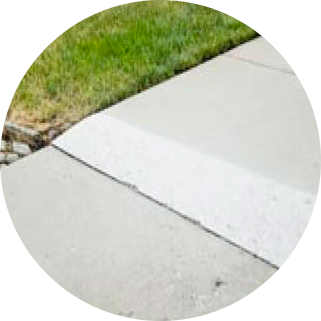
Our patented technology at Florida Sidewalk Solutions precisely removes these trip hazards by cutting the concrete to create smooth, compliant transitions. Unlike grinding (which often leaves rough surfaces) or total replacement (which breaks budgets), our cutting method provides a permanent solution that’s both cost-effective and minimally disruptive to pedestrian traffic.
Handrails
While not every sidewalk needs handrails, they become crucial safety features in certain situations. When a ramp rises more than 6 inches or extends beyond 72 inches in length, handrails become mandatory. The same goes for areas with stairs or walkways adjacent to steep drop-offs.
ADA-compliant handrails aren’t just any rails bolted to the side of a path. They need to be positioned at just the right height—between 34 and 38 inches. They must extend 12 inches beyond the top and bottom of ramps or stairs to provide support at the beginning and end of the transition. The gripping surface needs to be between 1-1/4 and 2 inches in diameter, and the rail must be continuous so users can maintain a steady grip throughout.
These seemingly small details make an enormous difference for people who rely on these supports for safe navigation. When properly installed, handrails transform potentially dangerous areas into accessible pathways that everyone can use with confidence.
By focusing on these key features—curb cuts, eliminating trip hazards, and appropriate handrails—municipalities can ensure their sidewalks are truly accessible to everyone in their community. And with Florida Sidewalk Solutions’ specialized cutting technology, achieving ADA compliance doesn’t have to break the bank or disrupt community life with lengthy construction projects.
Practical Steps to Achieve ADA Compliance
Achieving ADA compliance isn’t just about following the law—it’s about creating safe, welcoming communities that everyone can enjoy. At Florida Sidewalk Solutions, we know that making sidewalks accessible can feel overwhelming, but it doesn’t have to be. With a clear, step-by-step approach, your journey to ADA compliance can be smooth sailing (or smooth strolling, if you’re feeling punny today).
Here’s exactly how to get started:
Onsite Evaluation
Your first step toward ADA compliance is understanding exactly where your sidewalks stand. At Florida Sidewalk Solutions, we begin with an onsite evaluation—think of it as a sidewalk “health checkup.”
Our friendly (and meticulous) technicians perform a comprehensive sidewalk survey, carefully inspecting every inch to identify trip hazards, improper slopes, missing ramps, and other ADA issues. We document each problem clearly, taking notes, measurements, and GPS mapping to precisely locate hazards.
Then, we prioritize these issues based on severity and traffic volume—ensuring your most critical trouble spots are addressed quickly. Don’t worry—we won’t leave you with a pile of confusing paperwork. You’ll receive a straightforward assessment that clearly shows you what needs to be done, and why.

Repair Plans
Once we understand your sidewalk’s current situation, it’s time to create a custom repair plan. At Florida Sidewalk Solutions, we believe every municipality deserves a solution that fits their specific budget, timeframe, and community needs.
We thoughtfully categorize each type of repair—such as trip hazard removal, proper slope correction, or installing detectable warning pads—to keep things organized and manageable. Our planning process prioritizes high-traffic areas and serious hazards first, making sure the most urgent needs get addressed right away.
We also help you establish a realistic budget and an achievable timeline. Our goal is always to minimize disruption to pedestrian traffic and ensure your sidewalks return to safe, ADA-compliant use as quickly (and affordably) as possible.
Contractor Selection
Choosing the right contractor is the final—and arguably most important—step in your ADA compliance journey. Not all contractors are created equal, after all.
When choosing a contractor, look for specialized technology and proven expertise in ADA compliance—not just general concrete repair. At Florida Sidewalk Solutions, we proudly use our patented concrete cutting technology that precisely removes sidewalk trip hazards without the noise, dust, or expense of traditional grinding or replacement methods.
Experience is key. You want a contractor who understands the ins and outs of ADA compliance and has a track record of successful sidewalk hazard removal. Our dedicated crews have helped communities across Florida—from Davie, Fort Lauderdale, and Coral Springs to Boca Raton, West Palm Beach, Miami, and Fort Myers—achieve ADA compliance smoothly and cost-effectively.
Cost-effectiveness matters too. Our unique cutting method is significantly more affordable than traditional grinding, scabbling, or sidewalk replacement. Plus, our process typically takes hours, not days, minimizing disruptions to pedestrians and local businesses.

Finally, pick a contractor that offers reliable geographic coverage. At Florida Sidewalk Solutions, we proudly serve communities statewide, so no matter where you’re located in Florida, we’ve got you (and your sidewalks) covered.
By taking these practical, manageable steps—evaluation, planning, and finding a trusted contractor—you’ll be well on your way to creating sidewalks that are safe, accessible, and ADA-compliant for everyone in your community.
Frequently Asked Questions about ADA Compliance
When cities or property managers decide to tackle ADA compliance for sidewalks, a few common questions tend to pop up. Since we get asked about these issues all the time at Florida Sidewalk Solutions, we’ve gathered the answers here to help you out.
What is ADA compliance for concrete?
ADA compliance for concrete sidewalks and walkways means meeting the accessibility guidelines set by the Americans with Disabilities Act (ADA). These standards make sure public spaces are safe and comfortable for everyone—especially folks with disabilities.
When it comes to sidewalk accessibility, ADA compliance involves several key points. For starters, sidewalks should have a smooth, stable, and slip-resistant surface that’s easy to use for wheelchairs, walkers, and pedestrians with mobility challenges. They should also provide a minimum width of 36 inches to comfortably accommodate wheelchair passage.
Slopes are another important part of ADA compliance. Sidewalks need to have a running slope no steeper than 1:20 (5%) and a cross slope no more than 1:48 (2%). Properly built curb cuts at intersections are also required for smooth wheelchair transitions.
At Florida Sidewalk Solutions, we specialize in ADA compliant concrete solutions that specifically address trip hazards and uneven sidewalks. Our patented method precisely cuts and levels concrete, quickly and affordably making your sidewalks ADA-ready—without the costly headaches of traditional grinding or full sidewalk replacement.
What is the slope of an ADA-compliant sidewalk?
When we talk about sidewalk slopes, ADA guidelines focus on two specific slope types: running slope and cross slope.
The running slope refers to the slope that’s parallel to the path you’re traveling. ADA standards say this slope shouldn’t exceed 1:20 (5%). If your sidewalk needs to be steeper than this for some reason, it has to be designed as a ramp instead, which brings in extra requirements like handrails and landings.
Then there’s the cross slope, which runs perpendicular to your direction of travel. ADA requires cross slopes to be even gentler—a maximum of about 1:48 (or roughly 2%). While that might seem tiny, it makes a big difference. Even a slightly steeper cross slope can make wheelchairs tricky to control and uncomfortable to use.
The good news is, Florida Sidewalk Solutions’ precise cutting method often allows us to fix minor slope issues quickly and affordably. Rather than tearing out sidewalks completely, we level them to the proper slope—saving you time and money.
What are ADA-compliant sidewalk bumps?
Believe it or not, some “bumps” on sidewalks are required by the ADA. These bumps, called detectable warning surfaces (or tactile warning pads), help visually impaired pedestrians know when they’re approaching a street crossing or other unsafe area.
ADA-compliant warning pads have a unique pattern—small, raised domes that you can feel underfoot (or with a cane). These domes measure exactly 0.2 inches high and follow a specific grid layout. They have to extend the full width of curb ramps or other hazardous transitions and must visually contrast with the surrounding sidewalk, typically appearing bright yellow or another noticeable color.
However, not all sidewalk bumps are created equal. While intentional bumps used as warning surfaces are helpful—and required by ADA—unintentional bumps caused by lifted or cracked concrete are trip hazards that you absolutely must fix.
At Florida Sidewalk Solutions, our job is to eliminate those accidental bumps and trip hazards. Our cutting-edge (pun intended!) ADA compliant concrete solutions let us quickly and safely level uneven sidewalks without grinding or replacing entire sections. It’s a smart solution to keeping sidewalks safe, accessible, and ADA compliant.

Conclusion
Creating accessible, safe sidewalks isn’t just about avoiding lawsuits—it’s a statement about the kind of community you want to build. At Florida Sidewalk Solutions, we’re proud to help cities throughout Florida achieve ADA compliant concrete solutions through our proven, cost-effective approach to sidewalk trip hazard removal.
Our patented technology stands apart from traditional methods like grinding, scabbling, or replacing concrete sidewalks entirely. Rather than costly, messy, and disruptive alternatives, our precise concrete-cutting method gently removes trip hazards, changing uneven sidewalks into smooth, ADA-compliant pathways.
With our approach, municipalities throughout Davie, Fort Lauderdale, Coral Springs, Boca Raton, West Palm Beach, Miami, Fort Myers—and everywhere in between—enjoy significant cost savings, faster project completion, and minimal disruption to pedestrian traffic. Most importantly, these communities become safer, more inclusive spaces for everyone—from elderly residents and wheelchair users to parents with strollers and kids on scooters (and let’s face it, anyone who isn’t paying attention to their phone!).
ADA compliance isn’t optional; it’s required by federal law. But beyond that, it’s simply the right thing to do. When sidewalks are safe and accessible, your community is more welcoming to everyone who visits, shops, explores, or simply goes for a stroll.
Whether you’re addressing a few isolated sidewalk bumps or tackling comprehensive ADA compliance projects citywide, our experienced team is ready to help. At Florida Sidewalk Solutions, we’ve earned our reputation by making difficult sidewalk repairs simple, straightforward, and affordable.
Ready to learn more about how our innovative, patented concrete cutting method can help your community achieve full ADA compliance—and save money doing it? Reach out to us today at Florida Sidewalk Solutions and find what makes us Florida’s trusted partner in sidewalk accessibility.


